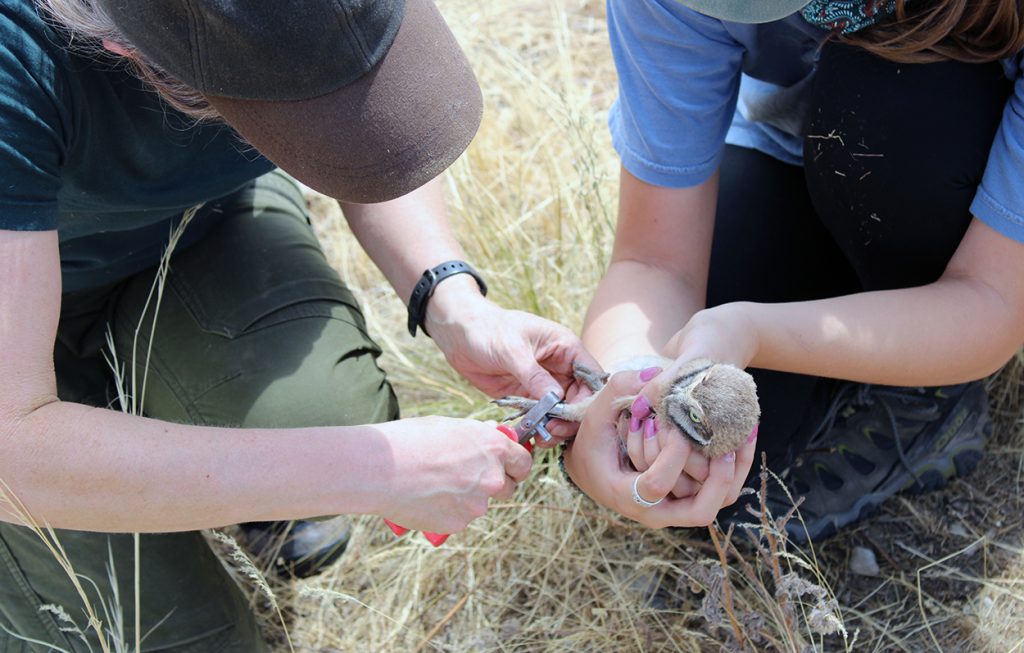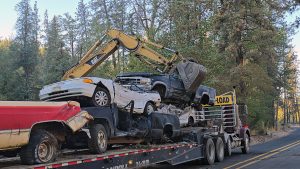By TRAVIS SNELL
HERMISTON – A biologist with the Confederated Tribes of the Umatilla Indian Reservation’s (CTUIR) Department of Natural Resources (DNR) concluded banding burrowing owl chicks for the nesting season on July 21 at the Umatilla Army Depot.
Visiting the last two nests for the season on the CTUIR’s land at the depot, Lindsay Chiono, DNR wildlife habitat ecologist-biologist, two Summer Youth Employment Program workers and a Whitman College biology student attached aluminum bands to the left legs of four chicks.
“That’s pretty average here as terms of nest productivity, and that productivity is driven by weather from year to year and the amount of vegetation and the effects on rodents and insects that are the main species that the owls feed on,” Chiono said.
The aluminum bands, which have unique identification numbers, go on the chicks’ left legs. This help determines when the birds were banded because owls that are banded for the first time as adults get bands on the right leg.
Chiono said the bands allow DNR employees to annually track the owls.
“We might catch the owls we banded here today as the mother or father of another nest, and so we’ll know where it was banded in the first place from this long-term data study that’s been going on for about 17 years,” she said. “We’ve learned a lot about these owls such as how many eggs they produce year to year, do they maintain the same nest location from year to year or do they change locations. We also know that about 85% of the males that we catch here were born here, which means about 15% came from somewhere else.”
Chiono said DNR has conducted its burrowing owl project since 2008 that has included approximately 100 artificial burrow sites.
“This is a huge success story. We came from about four nesting pairs in 2008 to over a hundred now. So each year we produce about at least 400 nestlings, and so that’s been going on for quite a while now,” she said.
After arriving at the artificial nest structure, the banding procedure involves a makeshift plunger made of sponges and PVC pipe to gently push down any birds that may be in the structure’s tunnel back into the nest.
Leaving the plunger in the tunnel so chicks can’t escape, Chiono removes the back of the nest chamber to look for chicks. When she finds a chick, she removes it and bands its left leg. She then weighs it and gives it a flea bath in diatomaceous earth. After removing the plunger from the burrow tunnel, the chick is released near the entrance so it can go back to the nest.
“The chicks at this state are only about 20 days old, and so we pull those out. They’re not real mobile yet. They can run around but they can’t fly yet, so they are pretty manageable and calm,” she said.
When the owls reach about 40 days, Chiono said, they can fly but stay at the nest until about October before moving to another location to feed before migrating.
Chiono added that DNR has a migration study that involves putting trackers on some owls to see where they migrate after the nesting season.
“So we’ve already learned quite a bit from that. For example, we’ve learned about how much area each of the owls is using for feeding,” she said. “We’ve also learned that some of the owls are migrating to central California. We had a few move over to western Oregon, which we didn’t expect last season, and then quite a few are staying here on the depot site the entire year long.”




